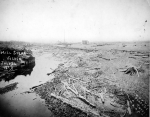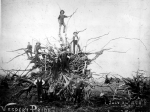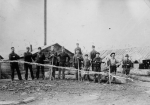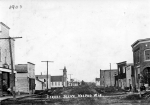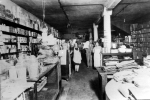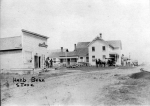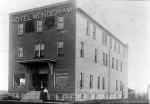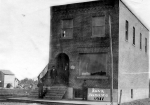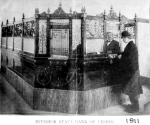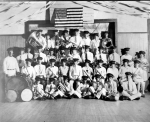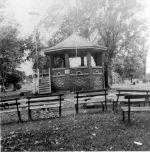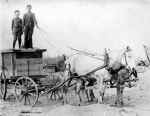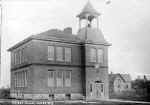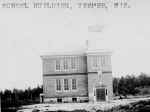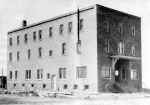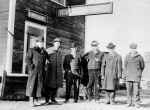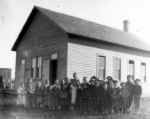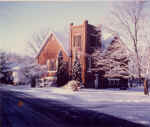These photographs were collected and annotated by Marlys Steckler.
McMillan Memorial Library has prepared them for the Internet with her permission.
|
|
Herman Dassow’s Store, Post Office, Goldsworthy’s, Summers, Lutheran Church, Woodruff's, Schecks’ In July 1898, Carsten Otto started a creamery. He sold it 2-3 years later to Ferdinand and Theodore Albert of Maryville. The company was known as the F. Albert Dairy Company and operated until it was destroyed by fire, seven years later. Vesper Christian Reformed Church was organized in 1898. It was located in a frame building 2 ½ miles northeast of the village. Most of the congregation was Dutch. They built a new building in 1905 which they enlarged in 1913. Early pastors were: Reverend Thomas DeLang, Rev. Arthur Guikema, Rev. Evert Van Korlaar, Rev. Dirk Wiednaar, Rev. John Van Den Hoek. On 9/11/1916, the Dutch Reformed Church was organized. It was later named the Faith Reformed Church. In 1948, the church moved to Wisconsin Rapids and a new building was dedicated in September.
Owen Oliver and George E. Martin established the Vesper State Bank in 1911. It was capitalized at $10,000 with a surplus of $2,500. The president was: George E. Martin, v-president: Owen Oliver, cashier: Burton Jones |
|
The bank grew slowly and in 1913, G. H. Horn became the president with A. P. Bean as vice-president, and F. W. Ellsworth as cashier and active manager. They experienced slow but steady growth. In August 1919, deposits totaled $55,000 with a capital of $10,000, and a surplus of $2,500. In 1919, Ellsworth retired and sold controlling interest to F. J. Wood, president of Wood County National Bank of Wisconsin Rapids, Guy O. Babcock, cashier of Wood County National Bank, and E. M. Witzig, assistant cashier of Citizen's National Bank of Wisconsin Rapids. Officers were: G. H. Horn - president, A. P. Bean - vice-president, E. M. Witzig - cashier. Directors were the three named above plus F. J. Wood, William H. Peters, and Watson Turner. Deposits increased to $140,000 with resources to over $200,000. Capital stock was $10,000 with a surplus of $8,600. George Baxter signed up to grow pickles for a well-known pickle company in 1913. They offered $.90/bushel of 1 – 3 1/2 inch pickles They would furnish the seed and show the farmers how to grow them profitably. They signed up about 150 acres near Vesper. Baxter planted one half acre (exactly 73 square rods). The soil was a sandy loam. He applied manure a few days before plowing and made rows 7 feet apart. The seed was put in by hand. When the plants were 4” – 5” high, they were thinned to one plant every 18-24 inches. The plot was cultivated three times during the growing season with a 1 horse cultivator. Picking began at the end of August and ran for six weeks. As no hired labor was available, Baxter, his wife, and 9 year old daughter picked nearly five bushels/day. One day when they could not pick, it cost them $10. They sold 196 bushels weighing 9,787 pounds or nearly 5 tons. He received $126.57 for a rate of over $250/acre. On 7/9/1948, the voters approved the incorporation of the village by a vote of 147-6. Only 45 of the qualified voters failed to vote. On 8/11/1948, a special election was held. Martin Hoeneveld, a resident since 1896, was elected village president by a 95-17 margin. Other officers were:
|
Lewis Johnson and Benjamin Gardalen constructed a sawmill in March 1910. Business ran until the 1920’s and was later dismantled. In June 1910, Albert Adams came to Vesper from New York City. He established a button factory with the knowledge he had gotten from being in New York. The factory employed 4 people. Harry N. Cole started the first ice cream parlor and confectionary store on 7/3/1910. He also ran a roller skating rink. He later moved to Nekoosa, Wisconsin.
|
|
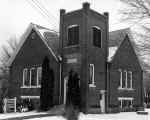
The first services by the Congregational Church were on July 24, 1898. The church actually was organized at a meeting on Jan. 2, 1899, at the home of John Murgatroyd. It was named Unity Congregational Church, which since then has been changed to Vesper Congregational Church. By 1902 the church ceased services and they were not continued again until 1910, when an arrangement was conceived with the Pittsville and Pleasant Hill Congregational Churches in regard to a pastor. The Vesper Congregational Church building was dedicated on Dec. 12, 1912, with the Rev. F. N. Dexter presiding. Cost of the building was $3,259.81 plus $285.00 for the interior furnishings. The property, worth $400, was donated by Goldsworthy. Pastor of the church at the time was the Rev. F. H. Brown. When the Vesper church became independent of the Pittsville and Pleasant Hill congregations, the Rev. Thomas A. Williams was the pastor. Early 1870's - Real business life began when Girard and Drake established a saw mill on the bank of the Hemlock Creek. The town grew on both sides of the Hemlock Creek which runs from northeast to southwest through the village and joins the Yellow River in the town of Remington. 1874 - Joseph White and his family arrived about the time the mill was established. He was foreman at the mill. Other arrivals about the same time were:
Girard and Drake sold the mill after 1 or 2 years to the Whorton Brothers, John and William Whorton of Appleton. They started to manufacture pine lumber. James W. Cameron came with them from Appleton and was their foreman for several years. James Cameron, Henry Sherry, and George Gerry bought out the Whorton Brothers and operated the mill until 1894. The first store in Vesper was opened by Girard and Drake. They sold it to the Whorton Brothers who in turn sold it to the Sherry-Cameron Lumber Company. It operated until the fire in 1894. 1854 - First land entries in the Vesper area are recorded Landowners named:
First settler was Sam Boynton, who later married and lived in Vesper until his death. |
[from a handwritten account] If you can use any of this I will be glad. Mrs. Mary Dolan 1888 First Sunday School was set up by Reverend Freeze, a Methodist missionary. Services were held each Sunday in the school house. Church alternated every other Sunday with Rudolph. They continued for 8 or 9 years with other ministers. 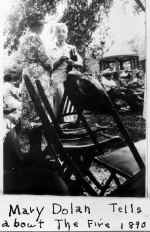
|
|
John Hassler was an early settler who was born on March 22, 1868 in Manitowoc County, Wisconsin. He was a well known cook. In 1894, he bought a farm consisting of 54 acres in Section 7 of the Sigel Township, now part of the village. He grew hay and corn crops, raised Guernsey cattle that were bred with a pure-bred sire, and also raised pure-bred Rhode Island Red Poultry 1896 Theodore Hoeneveld and his family settled near Vesper when several Dutch people came to the area. Children of the couple were: Martin, Claus, John, Marie, Kate. Marie later married Ernest Koch and Kate later married Chester Camlin. 1910 First newspaper, "The Pioneer", was an 8 page weekly paper that began publishing on 7/14/1910. It was managed by Kate C. Hoeneveld and John Hoeneveld until April 1918. Kate went to Washington D.C. during World War I to do government work. She married Chester Camlin, a disabled soldier from South Carolina. They returned to Vesper and resided here until her death in 1933. John continued publishing "The Pioneer" until September 1918 when he was drafted. A job printing office was run in connection with the paper. It was continued by John after his army discharge until his death on August 1, 1920.
|
1. Jake Bord X. A. D. Bean, Philip Bean 1902? Or 1906? The Vesper Brick and Tile Company was established by John Murgatroyd and Sons in the southwest part of town. The clay in the Vesper area was an excellent material for making bricks and tile. Capacity at the plant in 1911 was 25,000 bricks per day plus up to 8,000 tile. The shortage of coal during WWI forced the plant to close. Murgatroyd sold the plant after the war but it was returned to him about 2 years later. Almost all of the bricks used in construction in Vesper before the late 1920's came from the plant. In 1927, Professor George J. Barker of the University of Wisconsin Ceramic Department, surveyed the soils and discovered the clay was excellent quality. After that, the company became a stock corporation with Barker as a major stockholder. In 1933, because of a shortage of laborers, Barker arranged for the state to receive materials produced at the brick factory at cost in exchange for employing prisoners from the state prison at Waupun. After 2 years, tile was sent to Oregon where union workers discovered that the tile was produced by prison labor. They refused to work on the project and that ended the use of prison labor. In 1946, the business was sold to Jess and Frank Yeske. 
|

Carsten Otto and Herman Dassow formed a partnership and opened a general store on 1/1/1904. In 1905, Herman Dassow purchased the full interest of the operation. Elmer Dassow, his son, later operated the store. The Vesper Safety Clevis and Malleable Iron Company was built in 1908 by C. R. Goldsworthy of Vesper, John N. Hayes of Oshkosh, L. H. Bartholomew of Milwaukee, and F. W. Darling of Wautoma. It started operating on 7/13/1909 but closed after only 11 months because of the lack of business. The building was later used as a machine shop and auto garage. |
The first school was constructed in 1887 in the eastern part of the village. Following the 1894 fire, the small wood building was moved to a more central location in the school district, west of Vesper. Classes were also conducted in Adams Hall for a time. The present school building, a two-story brick structure, was erected in 1906. Anna Getchal was the first teacher in the present building. Cameron Park, located in the Center of the village, originally was owned by Benson and Anderton, who sold it to Goldsworthy. The latter, in turn, deeded the property to the village for use as a public park. The first Sunday School established in Vesper was set up by a Methodist missionary, a Rev. Mr. Freeze, in 1888. Services were held each Sunday in the schoolhouse. |
|
The Monogram Hotel was built by C. R. Goldsworthy. It was destroyed by fire in the mid 1920's. 1911 Elmer Trickey established the town's second newspaper, The State Center. He also owned the Monogram Hotel for a few years prior to 1916. His grandmother was a cousin to Daniel Webster. Picture taken in 1908 or 1909 Horn Hardware, Vesper Opera house, Harry Cole George H. Horn came to Vesper in 1902. He was born in Sheboygan County, Wisconsin on 3/13/1876. He married Melda Goldammer in Sheboygan County, Wisconsin. He bought a lot on Cameron Avenue and built a hardware store. It opened on 2/1/1904 and he gradually added farm machinery. In 1909, he built a two story brick store with a full basement and a large adjoining warehouse. He also operated a tinning and plumbing business. In 1923, he was president of the Vesper Silo and Tank Company. He was also the president, director, and stockholder in the State Bank of Vesper. In 1946, he sold his hardware business to his nephew, Jerome Seifert, and Ray Bean St. James Catholic Church was organized by the Rev. John Willitzer of Pittsville, who said the first mass in Adams Hall on Oct. 15, 1909. Prior to this Vesper Catholics worshipped in churches at Rudolph and Grand Rapids. |
James Carroll donated an acre of land to the parish and the present church structure was erected there. The building was dedicated on Nov. 24, 1910, by the Most Rev. Bishop Schwebach, D. D. The parish remained a mission of Pittsville until Aug. 1, 1919 and thereafter the Rev. C. W. Gille was appointed as the first resident pastor of the St. James Church. 1. [unknown] 2. Dave Woodruff 3.[unknown] 4.[unknown] 5. D. M. McVicar 6. Emery Bennett First catholic mass was held in Adams Hall on October 15, 1909. Before that time, they traveled to Rudolph and Grand Rapids. Reverend John Willitzer was the organizer. James Carroll donated an acre of land and early church members purchased an additional 3 acres. St. James Catholic Church, a brick building, was dedicated on 11/24/1910 by the Most Reverend Bishop Schwebach, D.D. The parish remained a mission of Pittsville until 8/1/1919. Reverend C. W. Gille was the first appointed resident pastor. While he was there, the rectory was built and a church steeple was added. Pastors that followed were: Reverend A. M. Kammer Charter members were: Mrs. Mary Adams, Jacob Sternot, Mrs. Joseph Hladilek, Mr. And Mrs. Charles Hladilek, Mr. And Mrs. Joseph Rokus, Mrs. Celia Goldammer Early trustees were Joseph White and Frank Laddick. President of the Altar Society was Mrs. Henry Treutel. Secretary was Mrs. John Flanagan and Treasurer was Mrs. Celia Goldammer. First organist was Mrs. Joseph Mras whose maiden name was Mary Sternot. |
 Ed Beck Elsie Staven Milton Gum Equitable Creamery Company, a farmer's cooperative, was started on November 20, 1907 on an acre of land granted to the company by C. R. Goldsworthy for $1. It operated as a creamery and cheese factory except for 1 or 2 years until 1921. The officers were all leading dairy farmers. President: O. J. Leu Vice-President: H. Hackbarth Secretary: A. P Bean Treasurer: William Ehlert Director: John Joling On October 17, 1921, Fred Hadler purchased Equitable Creamery Company and installed new machinery. He was born in Plymouth, Wisconsin in Sheboygan County on April 7, 1874 to George and Crissie (Gossman) Hadler. The Creamery later operated as the American Milk Products Company, The White House Company, and Western Condensing Company. In the late 1930's and early 1940's, the plant made the base used to make penicillin. In 1951, Frank Gill purchased the factory and started Gill's Wholesale and Retail Wall Paper Business. Sanna Dairies bought the creamery business and built a new plant.
Early 1900's - After the fire of 1894, the land was not suitable for crop farming but it was adaptable to dairy farming and raising cattle. Jacob Schmidt introduced pure-bred Holstein dairy cows to the area. Names associated with Holstein history in and around Vesper include:
Many herds of registered Guernseys and Jerseys were also in the area. Names connected to the Guernsey history were:
The Four High Herds Highest Herd Second highest Herd Third Highest Herd Fourth Highest Herd Early 1900's - Businesses were established to serve the dairy farmers who couldn't take time to travel 20 miles to Marshfield or 10 miles to Wisconsin Rapids. Outlets for their milk were The White House Milk Co. in Vesper, Wisconsin Valley Creamery Co. in Wisconsin Rapids, Rudolph Central Cooperative Creamery Co., and Arpin Milk Products Co. There were also several private and cooperative cheese factories. |
The first blacksmith shop was set up by the Sherry-Cameron Lumber Company. In November 1901, Charles and Henry Treutel established a smithy. C. R. Goldsworthy and E. S. Bailey started a general store. They sold it after 3 years to Oscar and Walter Treutel. The building was later used as the village hall.
1901 Goldsworthy donated the land upon which the Evangelical Lutheran Church was built. The congregation, organized about 1900, was for many years served by the pastor of the Evangelical Lutheran Church of Arpin. The name of the church has since changed to Trinity Lutheran Church. Around 1900, Trinity Lutheran Church began as the Evangelical Lutheran Church. It was built on land donated by C. R. Goldsworthy. The congregation was served for several years by the pastor of the Evangelical Lutheran Church of Arpin. One of Vesper's oldest buildings was the John Zieher Hotel. It was rented out as apartments and rooms. At one time, it was used as a feed mill. The addition was used by the telephone office until the telephones were converted to the dial system. The building was razed by Douglas Brockman of Vesper, except for the newer addition which was moved to a farm, one mile north of the village. The Fairview Cheese Factory was established in 1902 about 2 ½ northwest of Vesper. It was the first co-op cheese factory in Wood County. |

The first services of the Unity Congregational Church were held on 7/24/1898. The more formal church was organized at a meeting at John Murgatroyd's home on 1/2/1899. In 1902, services were stopped until 1910 when arrangements were made with Pittsville and the Pleasant Hill Congregational Churches for a pastor. On December 12, 1912, the Vesper Congregational Church was dedicated. The cost of the building was $3259.81 plus $285 for the interior furnishings. Land, valued at $400, was donated by C. R. Goldsworthy. R. F. Brown was the pastor at that time. The Vesper Church became independent of Pittsville and Pleasant Hill when Reverend Thomas A. Williams was their pastor. A story in the Sept. 1, 1894 edition of The Centralia Enterprise gave this description of the fire which occurred on Aug. 28. 1894; "The thriving little town is all but wiped out. Ashes and ruins mark the site of its former industry. The sawmill, planing mill, lumber in the yards and about 25 dwelling houses, in fact all of the little town west of Hemlock Creek, was totally wiped out by the fire. "The fire had its origin in the forest fires that have been running throughout that region for weeks. But no immediate danger was apprehended. Tuesday afternoon about half past three o'clock the wind shifted to the south, and before anyone was aware of the danger, the fiery element was beyond man's control. The fire was first observed in a large boarding house in the southwestern part of the town. From here it leaped with ferocious rapidity to adjoining dwellings and into the lumber yard where about 9,000,000 feet of lumber were piled. Everything was dry as tinder, owing to the long drought. "The sawdust burned like powder and a strong wind swept waves of flame over the doomed portion of the town. Half an hour after the fire started, the mills, lumber piles and houses were one angry roaring mass of flames. "There was time to save but little. Mrs. J. W. Cameron was sick abed at the time and her safety was first looked after. After that there was only time to save Mrs. F. J. Cameron's handsome piano and a box of furs from Mr. Cameron's residence. Few people had time to save anything. "Fears for the safety of the other part of town resulted in a call to the Grand Rapids fire department. Hurriedly the fire engine and hose carts were taken down to the stricken town via the Port Edwards, Centralia & Northern road, but the company could be of little service. A strong south wind blew the smoke and heat away from the east half of the town and there was, hence, but little danger from fire in that quarter. "The mills and the lumber belonged to the Sherry-Cameron Lumber Co. The plant consisted of a double-band sawmill and a planing mill (and the 9,000,000 feet of lumber ). The loss to the company will amount to $150,000 covered by insurance to the amount of about $90,000. "The fire will probably mean the wind-up of affairs at Vesper, as the mill will not be rebuilt, all of the timber of the company having been cut." 1894 - Following the fire, the Sherry-Cameron Lumber Company sold their holdings to Edward A. Benson and Charles E. Anderton of a Milwaukee real estate firm. They bought 11,000 acres at $2.50/acre. The purchase included the 100 acres that the village was on. Clifford R. Goldsworthy later traded them some property in his native Racine County for 100 acre village site. Goldsworthy helped Benson and Anderton sell their land. As many as two to three farms sold each day for about 1 ½ years. They sold the balance of their land to Goldsworthy, who employed Charles Hull to clear the land of stumps for the settlers. In 1896, Goldsworthy moved to Vesper. He was a leading figure in its redevelopment. He engaged in several occupations over the years ranging from farming to starting a lumber business to operating a store, hotel, and a real estate business. In the early 1900's, he built a saw mill near the Hemlock Creek in the southwest part of town. A short time later, he took on Colin McNicol as a partner. It burned down 7 or 8 months later. McNicol then built a saw mill but died soon after it was built. It was later sold to Dave C. Woodruff and moved away. Goldsworthy was a member of the town of Hansen board and also served as its chairman. He was elected to the State Assembly in 1905 and served for 2 years. He deeded the 300' by 300' plot of land to the town of Hansen which is known as Cameron Park. Goldsworthy died in 1946 in Vesper. |
Edward I. Philleo, a civil engineer, surveyed and platted the village from 9/14/1897 - 10/1/1897. He subdivided the land into blocks and lots. Owen Oliver and George E. Martin established a real estate firm in Vesper. It was known as the Oliver-Martin Land Company. The following passage is attributed to them. Describing their first visit to Vesper (1897) they said: "Vesper…was about the most forlorn and forsaken hamlet one could expect to see, but notwithstanding its homely appearance and the contrast which then existed between that part of the state from which we came (Waukesha and South Wayne) and the county of Wood, the impression was such that we were convinced that some day Wood county would reach the highest pinnacle in the point of wealth." They based their opinion on the farming potential of the area. In 1910 they said: "We have no hesitancy in predicting that before the close of another decade Wood county will rank among the foremost dairy counties in the state. There were over 100 silos built in Wood county in 1910 and it is said that 200 or over will be built in 1911. The best move a farmer makes is to establish a silo." The Fairview Addition was platted by Edward I. Philleo on March 1 - 3, 1910. The owner was D. McVicar. The land was between Wisconsin and Michigan Streets and Cameron and 4th Street. The Fairview Second Addition was platted by G. W. Severns, the county surveyor, on June 21, 1921 at the request of Howard Lee Fleming. The land lies in Section 18. The Vesper Wood Manufacturing Company was organized in 1909.
The company made stave silos, stock water tanks, and other wood articles. The 1917, McVicar and Ludwig sold to Horn and Woodruff and the name changed to the Vesper Tank and Silo Company. Product demand diminished and the plant was dismantled. 
|


